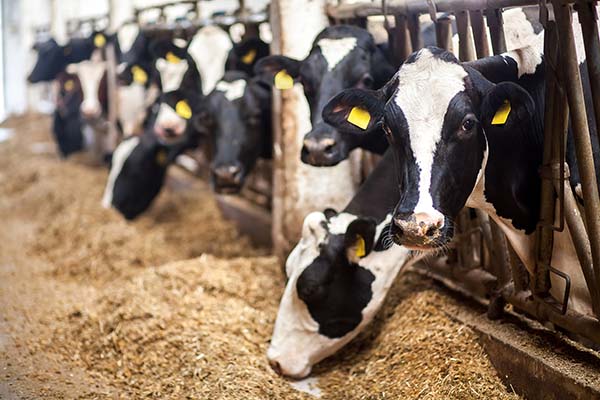A 20th century vision that was ahead of its time remains so today, some 30 years after its conception: The Alltech ACE principle is a corporate “North Star,” serving as a guide to a more sustainable, healthier world.
The “A” in ACE is all about the animal and innovating ways to balance highly efficient and profitable livestock production with the seemingly conflicting imperatives of environmental stewardship and consumer demand.
A focus on precision nutrition
Alltech’s animal health and nutrition business revolves around the science of nutrigenomics — how diet impacts genetics — and a quest for a better understanding of how to feed an animal to its specific genetic potential.

An Alltech researcher reviews markers of gene expression, which provide a better understanding of how changes in the diet affect animals at the genetic level.
“The more efficient that we can make these animals, the better off we are because we can get more meat, milk or eggs per pound of feed,” noted Dr. Kristen Brennan, a research project manager at the Alltech Center for Animal Nutrigenomics and Applied Animal Nutrition. “The focus of the nutrigenomics that we do is to understand how nutrition influences animals on a molecular level and how that can lead to changes that we see in production, health and well-being.”
Good for the animal, producer, environment and us
Intensive livestock operations produce large quantities of animal waste, which can include high levels of ammonia, nitrogen, phosphate and trace minerals. However, proper animal nutrition can minimize the levels and impacts of these pollutants.

Alltech scientists are working to develop products that reduce methane emissions while improving the efficiency of the animal.
“These products must reduce methane emissions from the rumen without negatively impacting rumen fermentation and negatively impacting either the milk production or growth of beef animals,” said Dr. Amanda Gehman, Alltech research project director.
Finding that balance is also a focus at Alltech-owned KEENAN, the Ireland-based manufacturer of advanced diet feeders and software products.

“What we’re all trying to do is to increase feed conversion efficiency (FCE) on the farm,” said Conan Condon, director of KEENAN's InTouch live review and support service. “We want to increase production while decreasing the intake of the animals. By doing that, you will increase your FCE and reduce your carbon footprint.”
For Alltech Chief Scientific Officer Dr. Karl Dawson, a significant and all-encompassing ACE milestone was reached when the company introduced Optigen®, a non-protein nitrogen source for ruminants.
“That had a tremendous impact in terms of what it would do for animal feeds,” said Dawson. “It not only improved animal performance, it changed the way nitrogen is utilized in cattle. It made nitrogen efficiency much greater, and you have less nitrogen in waste.
“Nitrogen in waste is the precursor to one of the major greenhouse gases, nitrous oxide, which is a stronger greenhouse gas than methane,” he continued. “You can reduce greenhouses gases using that technology.”
Healthy animals, healthy humans
Dawson is equally focused on addressing today’s widely held consumer concerns about the use of antibiotics in livestock production as a growth promotant. Alternative solutions are being found in enzyme technologies that are becoming the backbone of Alltech nutritional programs and technologies.
“We have systems that can induce the same types of changes that antimicrobials have induced using these enzymes and manipulating what’s going on in the digestion process,” he said. “As time goes on, that is going to be a real game-changer.”
The potential for using low levels of these enzymes as additions to feed can be as powerful as any of today’s antimicrobials, according to Alltech researchers.
“We’re producing alternatives to antibiotics in the diet that satisfy both the needs of the farmer and the production needs of the animal and also make the consumer happy because those compounds are omitted from the diet,” noted Brennan.
Environment and economics — must they be at odds?
Environmental sustainability has appeared to be at cross purposes with economic growth and development. Achieving high efficiency has been thought to come at the expense of the food-producing animal and the environment.
“In general business, those two things can be at odds, but in cattle — and in animal agriculture, in general — efficiency really is the name of the game as far as producing less waste, less environmental pollutants per unit of milk, beef or eggs,” said Gehman. “But it’s also the same efficiency that can be applied to profitability.
“In cattle, methane is an indicator of waste, not just to the animal but also to profitability, so if that animal is burning off energy as a waste product and we can make the animal more efficient so that she retains more of that energy, that can be environmentally sustainable as well as profitable for the farm,” she continued.

Dr. Amanda Gehman, Alltech research project director, evaluates a total mixed ration using the Alltech® In Vitro Fermentation Model, or IFM. Improving digestibility of the diet can have a significant effect on producer profitability and environmental sustainability.
Gehman is now investigating in vitro testing (using the Alltech® In Vitro Fermentation Model, or IFM) as a means of evaluating the digestibility of various forages.
“We’re making that a regular test in order to fine-tune the rations, to address problems as they come and also address any opportunities to use an undervalued feed,” she said.
Minerally minded
While Gehman and her colleagues study ways to optimize ruminant digestion, other Alltech researchers have been focusing on how producers can feed substantially fewer organic trace minerals than inorganic trace minerals and get similar, if not better, performance.

Dr. Karl Dawson, vice president and chief scientific officer at Alltech, works with ICP-MS, instrumentation used to measure the proportion of minerals in feed or food samples and their distribution in biological matrices, animal tissues or human biological fluids. Methods such as ICP-MS are routinely used by Alltech researchers as they seek to define the true mineral requirements of animals.
The company’s mineral management program, Total Replacement Technology™ (TRT), has been at the forefront of a transition from inorganic trace minerals that are not efficiently digested — and even banned in some countries — to feeding reduced levels of organic minerals that animals can better utilize, reducing environmental pollution.
Steve Elliott, global director of the Alltech® Mineral Management team, said the company’s scientists are also looking at the interaction of trace minerals with other components in the diet, such as enzymes, vitamins and antioxidants.
“We’ve found that trace minerals can have a very negative impact on those other diet components,” said Elliott. “Research has now shown that, by using organic trace minerals, we avoid some of that conflict or interaction, thus allowing those other components to do what they’re put into the diet to do.”
Ending the reliance on fish oil and fish meal
Some methods of aquaculture have a very high environmental impact. A common sustainability problem in animal and aquaculture diets is the nutritional requirement of fish oil or fish meal, which is typically from wild fish.
The problem with fish oil — and this really goes to sustainability and the ACE principle — is that fish oil and fish meal demand have been increasing. Fisheries around the world are at capacity, and fishing more out of them risks collapsing them. The alternative is aquaculture, but in that case, there is not enough algae in the spaces that the fish occupy. You’re feeding the fish, and at this point, the ratio of conversion is that you have to 'squeeze' one fish to get enough fish oil to feed one fish. With demand increasing, that’s not sustainable, long-term.
Dr. Jorge Arias, Alltech’s global director for aquaculture, is optimistic about algae as an answer.
“We believe we have a real solution in our algae that will reduce reliance on fish oil while increasing the amount of DHA available to farmed fish and, ultimately, to consumers,” he said.
Sustainable seafood
To further address issues of fish farming, the Alltech Coppens Aqua Centre recently opened in Valkenswaard, the Netherlands.

“This is a brand-new knowledge hub for the development of innovative fish nutrition solutions to tackle both the present and future challenges facing the aquaculture industry,” said John Sweetman, Alltech's European technical manager for aquaculture.
Those methods include products derived from microalgae that are fully safe, sustainable and traceable, while providing the nutritious DHA previously supplied by fish oils.
ACE-ing animal health and nutrition
Alltech takes a holistic approach to animal health and nutrition, mindful of what is best not only for the producer, but also the ruminant, fowl or fish that feed a growing population and the planet they all call home. This article has touched on but a few of the many products, programs and concepts provided by the global Alltech research and development community to live out its ACE principle commitment
Next in our series will be the “C” in ACE: the consumer. We’ll look at the many ways Alltech strives to respond to the expectations of the information-seeking “prosumer” of the 21st century.
Read ACE-ing sustainability: Part I, the environment.




























